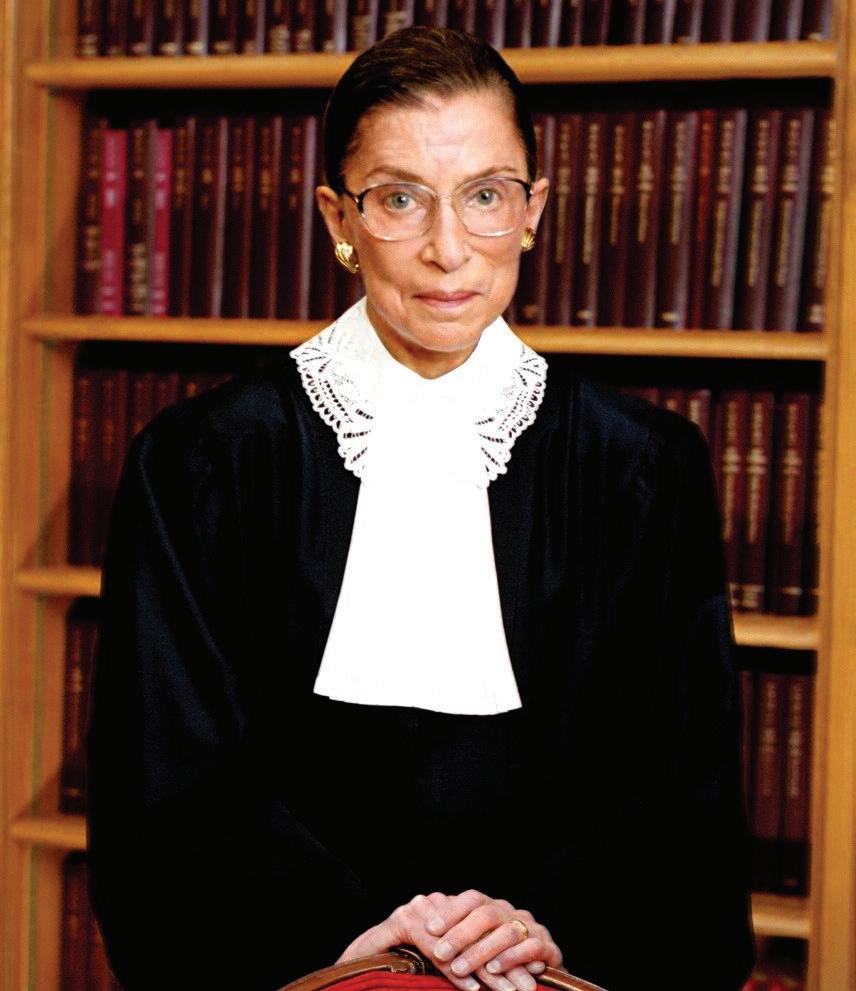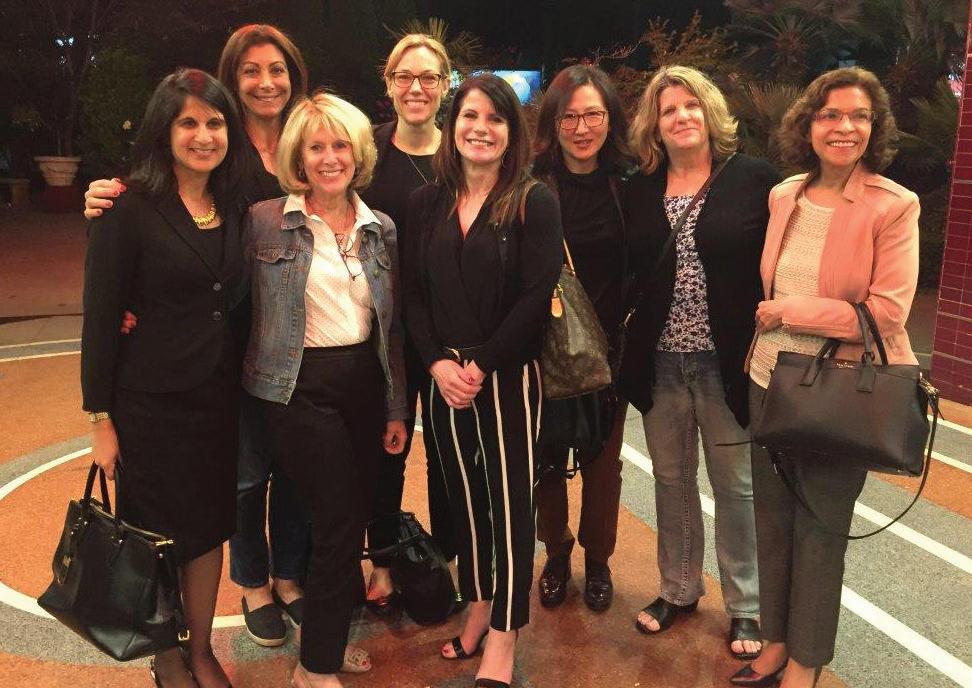
5 minute read
REMEMBERING JUSTICE RUTH BADER GINSBURG
By Judge Emily E. Vasquez
Judge Emily E. Vasquez is a judge in Department 32 of the Sacramento County Superior Court.
Advertisement
Late in the afternoon of September 18th, Judge Helena Gweon texted me and some female judicial colleagues to inform us of Justice Ruth Bader Ginsburg’s death. The news brought a deep sense of loss and sadness. Soon my friends and I were sending messages to one another expressing our grief, but also encouraging one another to honor Justice Ginsburg by continuing her legacy of moving toward a more just and more equal America. My female judicial colleagues and I felt a special loss because we were an informal “RBG” Sacramento contingent. Together, we shared dinner and watched two powerful movies about Justice Ginsburg: the documentary “RBG” and the historical drama, On the Basis of Sex. We
Collection of the Supreme Court of the United States Photographer: Steve Petteway
She Imagined a World of Greater Equality and Then Worked to Make It Happen
reminisced and were uplifted by her response to the question of how many women would be enough on the Supreme Court. Justice Ginsburg answered: “When there are nine, people are shocked. But there’d been nine men, and nobody’s ever raised a question about that.” She was a hero to us.
Justice Ruth Bader Ginsburg made it her life’s work to change the legal landscape for American women, first as a civil rights lawyer and then as the second woman ever to serve on the US Supreme Court. But in the process, her work helped not only women, but also men, racial minorities, people with disabilities, and workers.
While teaching at Rutgers University Law School, she became co-director of the Women’s Rights Project of the American Civil Liberties Union (ACLU) and set about changing the Supreme Court’s view of gender bias. With her meticulous legal research and keen intellect, she argued a series of landmark cases that extended the 14th Amendment’s equal – rights clause to women, overturning laws that discriminated on the basis of sex. She beca-

“RBG” Sacramento Contingent From Left to Right: Hon. Shama Mesiwala, Hon. Sharon Lueras, Hon. Judy Hersher, Hon. Lauri Damrell, Hon. Jill Talley, Hon. Helena Gweon, Hon. Laurie Earl, and Hon. Emily Vasquez. me to women what Justice Thurgood Marshall was to African Americans.
In 1996, three years after being appointed to the US Supreme Court by President Bill Clinton, she wrote the landmark decision that struck down the Virginia Military Institute’s men-only admissions policy, a ruling she called the culmination of her efforts “to open doors so that women could aspire and achieve without artificial constraints.”
In her later years on the Supreme Court, Justice Ginsburg became the leading voice of its liberal minority, issuing sharply worded and powerful dissents supporting reproductive rights, affirmative action, workers’ rights, and voting rights. It was her hope that some of her dissenting opinions might sway a future court. She explained, “Dissents speak to a future age . . . But the greatest dissents do become court opinions and gradually over time their views become the dominant view. So that’s the dissenter’s hope: that they are writing not for today, but for tomorrow.” It was her dissents which elevated her to pop-culture icon. As a demonstration of her sense of humor and spirit, Justice Ginsburg took to switching the decorative collars she wore with her judicial robe on days when she would be reading majority or dissenting opinions from the bench. The collars were carefully selected to signal her meaning. She even had a decorative necklace/collar that was observed to be her “dissenting collar.” Her marriage was a love story for the ages. She and her husband, Martin Ginsburg, were equal partners in marriage and parenting. Marty Ginsburg, a highly successful tax attorney, supported her dreams and ambitions and celebrated her many achievements. While Justice Ginsburg pursued her career, Marty took on the task of cooking for the family with great skill and joy, much to the delight of their two children, Jane and James. Today we take for granted her vision of gender equality. But we should never forget that it was not until 1971 that the Supreme Court ruled for the first time that the Constitution prohibits discrimination based on sex. In Reed v. Reed (1971) 404 U.S. 71, the US Supreme Court held that the words of the 14th Amendment’s Equal Protection Clause covered women as well as men and, thus, the state could not automatically prefer men over women as executors of estates. Let us not forget that it wasn’t that long ago when women couldn’t even get a credit card. And, sexual harassment was not recognized as a cause of action as a form of sex discrimination under Title VII of the Civil Rights Act of 1964 by the courts until the mid1970s and 1980s.
As the first in my family to graduate from college and law school, I was inspired by Justice Ginsburg’s courage and determination to make our nation live up to its ideals and to preserve its rule of law, equally and equitably for everyone. I attended law school in the mid-1970's when there were very few women and even fewer Latinas in the legal profession. My entering class at Berkeley Law in 1974 was about 1/3 women, which at the time was quite impressive. My law school female friends and I wondered whether the legal profession would accept us as attorneys, as litigators. We wondered whether we would be able to have a family and a legal career. Today, of course, there are many more positive female role models in senior positions than ever before. Now, when I meet with women law students, they envision working at a law firm and becoming partners or becoming the chief legal counsel for a public agency or eventually being appointed to the bench, all while juggling the demands of home and family. It is wonderful to behold. I suppose to the younger generation, we seem to have successfully handled a family and a career, and we are finally providing the role models that we never had. Justice Ginsburg showed us that we could mix families and careers and do it well.
Thank you Justice Ginsburg for paving the way for women’s equality before the law, and for women’s rights to be taken seriously by the courts and by society. Rest in peace; you have provided us with the legal tools to carry on.

